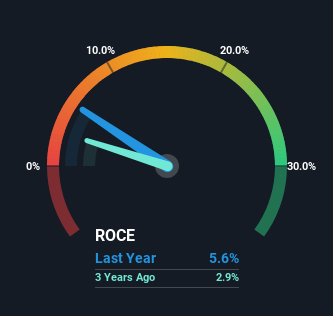If we want to find a stock that could multiply over the long term, what are the underlying trends we should look for? One common approach is to try and find a company with returns on capital employed (ROCE) that are increasing, in conjunction with a growing amount of capital employed. Basically this means that a company has profitable initiatives that it can continue to reinvest in, which is a trait of a compounding machine. However, after briefly looking over the numbers, we don't think Honda Motor (TSE:7267) has the makings of a multi-bagger going forward, but let's have a look at why that may be.
Understanding Return On Capital Employed (ROCE)
If you haven't worked with ROCE before, it measures the 'return' (pre-tax profit) a company generates from capital employed in its business. Analysts use this formula to calculate it for Honda Motor:
Return on Capital Employed = Earnings Before Interest and Tax (EBIT) ÷ (Total Assets - Current Liabilities)
0.056 = JP¥1.1t ÷ (JP¥27t - JP¥7.4t) (Based on the trailing twelve months to December 2023).
So, Honda Motor has an ROCE of 5.6%. Ultimately, that's a low return and it under-performs the Auto industry average of 12%.
Check out our latest analysis for Honda Motor

In the above chart we have measured Honda Motor's prior ROCE against its prior performance, but the future is arguably more important. If you're interested, you can view the analysts predictions in our free analyst report for Honda Motor .
What Can We Tell From Honda Motor's ROCE Trend?
The returns on capital haven't changed much for Honda Motor in recent years. The company has employed 41% more capital in the last five years, and the returns on that capital have remained stable at 5.6%. Given the company has increased the amount of capital employed, it appears the investments that have been made simply don't provide a high return on capital.
What We Can Learn From Honda Motor's ROCE
In conclusion, Honda Motor has been investing more capital into the business, but returns on that capital haven't increased. Although the market must be expecting these trends to improve because the stock has gained 100% over the last five years. However, unless these underlying trends turn more positive, we wouldn't get our hopes up too high.
If you're still interested in Honda Motor it's worth checking out our FREE intrinsic value approximation for 7267 to see if it's trading at an attractive price in other respects.
For those who like to invest in solid companies, check out this free list of companies with solid balance sheets and high returns on equity.
Valuation is complex, but we're here to simplify it.
Discover if Honda Motor might be undervalued or overvalued with our detailed analysis, featuring fair value estimates, potential risks, dividends, insider trades, and its financial condition.
Access Free AnalysisHave feedback on this article? Concerned about the content? Get in touch with us directly. Alternatively, email editorial-team (at) simplywallst.com.
This article by Simply Wall St is general in nature. We provide commentary based on historical data and analyst forecasts only using an unbiased methodology and our articles are not intended to be financial advice. It does not constitute a recommendation to buy or sell any stock, and does not take account of your objectives, or your financial situation. We aim to bring you long-term focused analysis driven by fundamental data. Note that our analysis may not factor in the latest price-sensitive company announcements or qualitative material. Simply Wall St has no position in any stocks mentioned.
About TSE:7267
Honda Motor
Develops, manufactures, and distributes motorcycles, automobiles, and power products in Japan, North America, Europe, Asia, and internationally.
Established dividend payer and good value.
Similar Companies
Market Insights
Community Narratives



